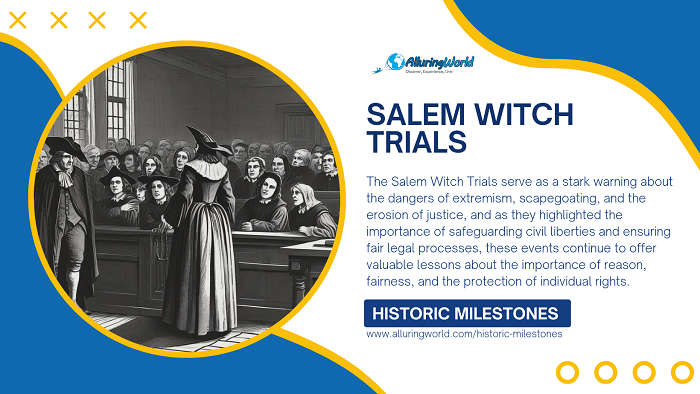Read time ca. 4 minutes
The Salem Witch Trials, which were held between February 1692 and May 1693, are one of the most infamous episodes in early American history. As they were taking place in the Puritan settlement of Salem, Massachusetts, these trials led to the accusation, prosecution, and execution of individuals who were alleged to be practicing witchcraft, and the hysteria that gripped Salem left an indelible mark on the collective American memory, serving as a cautionary tale about the dangers of mass hysteria and injustice.
Origins of the Trials:
Considered to be one of the darkest chapters in American history, the Salem Witch Trials were a product of a confluence of factors. As the Puritan society that was deeply rooted in religious dogma believed in the existence of the devil and his ability to influence individuals through witchcraft, it was this belief system which fostered an atmosphere of fear and suspicion where the supernatural was seen as a constant threat. Furthermore, the Salem community was already grappling with internal tensions because land disputes, economic hardship, and social hierarchies created a climate of social unrest, and these underlying anxieties provided fertile ground for the hysteria that would soon engulf the town.
The outbreak of the trials was triggered by a series of strange events involving young girls who began exhibiting unusual behavior, including fits and hallucinations, and as these girls were convinced they were under the influence of witchcraft, they simply accused several local women of tormenting them. Because the accusations multiplied as they were fueled by fear and paranoia, a wave of mass hysteria swept through Salem, so the trials spiraled out of control, with numerous individuals facing accusations and facing severe consequences, including imprisonment and execution.
The Accusations and Trials:
The initial accusations of witchcraft in Salem disproportionately targeted marginalized members of the community, and individuals like Sarah Good who was a homeless beggar, Sarah Osborne who was an elderly and infirm woman, and Tituba who was an enslaved woman of Indigenous descent, were among the first to be accused. As they all faced immense pressure and fear of the unknown, Tituba unfortunately confessed to practicing witchcraft and, under duress, implicated others. This confession further ignited a wave of panic and fear which set the stage for a cascade of further accusations.
The court that was established by Governor William Phips, relied heavily on a controversial form of evidence known as spectral evidence, and this allowed accusers to testify that the spirit or specter of the accused had tormented them, even if the accused was physically absent. This type of evidence that was inherently subjective and unverifiable, proved devastating for the accused, but as it was coupled with the prevailing belief in the devil’s power and the intense fear that gripped the community, spectral evidence fueled the rapid escalation of accusations, leading to additional numerous arrests and tragic consequences.
The Executions and Aftermath:
As the trials unfolded with devastating consequences, over the course of the year there were more than 200 individuals who were accused of witchcraft, facing accusations of tormenting their accusers, causing livestock to die, and other malevolent acts. Of those accused there were 30 who were found guilty, and additionally 19 individuals, including men and women, were executed by hanging, while one man, Giles Corey, was subjected to the horrific practice of “pressing” to death for refusing to enter a plea. This quite barbaric method involved piling heavy stones onto his chest until he succumbed to the enormous weight above him.
The trials fortunately came to an abrupt end in May 1693 because the growing skepticism and criticism, both within and outside the colony, led Governor Phips to dissolve the court and prohibit further arrests. The aftermath of the trials was marked by a period of reflection and remorse within the Salem community, and as many residents grappled with the guilt and trauma of the events, acknowledging the injustice inflicted upon the accused, in later years, official apologies and reparations were made to the descendants of the victims, acknowledging the profound harm caused by the witch trials.
Historical Significance:
The Salem Witch Trials stand as a chilling testament to the devastating consequences of fear, superstition, and the erosion of social order. In a climate of religious fervor and societal anxieties, the trials spiraled out of control as they were fueled by unfounded accusations, and with the exploitation of vulnerable individuals who were seen as something of an obstacle to remove, the acceptance of specious evidence was something that did not concern the individuals who were conducting the court trials. The breakdown of legal safeguards, coupled with the unchecked power of accusers, led to the imprisonment, torture, and execution of innocent people, and the trials even today serve as a poignant reminder of the dangers of mass hysteria, the importance of critical thinking, and the imperative to uphold the rule of law and protect the rights of the individual, even in the face of widespread fear and uncertainty.
Conclusion:
To conclude everything, the Salem Witch Trials remain a potent symbol of the dangers of extremism, scapegoating, and judicial injustice, as they serve as a powerful reminder of the need for vigilance in protecting civil liberties and ensuring justice, and this dark chapter in American history continues to resonate, offering lessons on the importance of reason, fairness, and the protection of individual rights in the face of collective fear.

